instrument panel OLDSMOBILE SILHOUETTE 1997 Owners Manual
[x] Cancel search | Manufacturer: OLDSMOBILE, Model Year: 1997, Model line: SILHOUETTE, Model: OLDSMOBILE SILHOUETTE 1997Pages: 436, PDF Size: 21.87 MB
Page 40 of 436

or the instrument panel ... or the safety belts!
With safety belts, you slow down
as the vehicle does.
You get more time to stop. You stop over more distance,
and your strongest bones take
the forces. That’s why
safety belts make such good sense.
1-32
ProCarManuals.com
Page 52 of 436
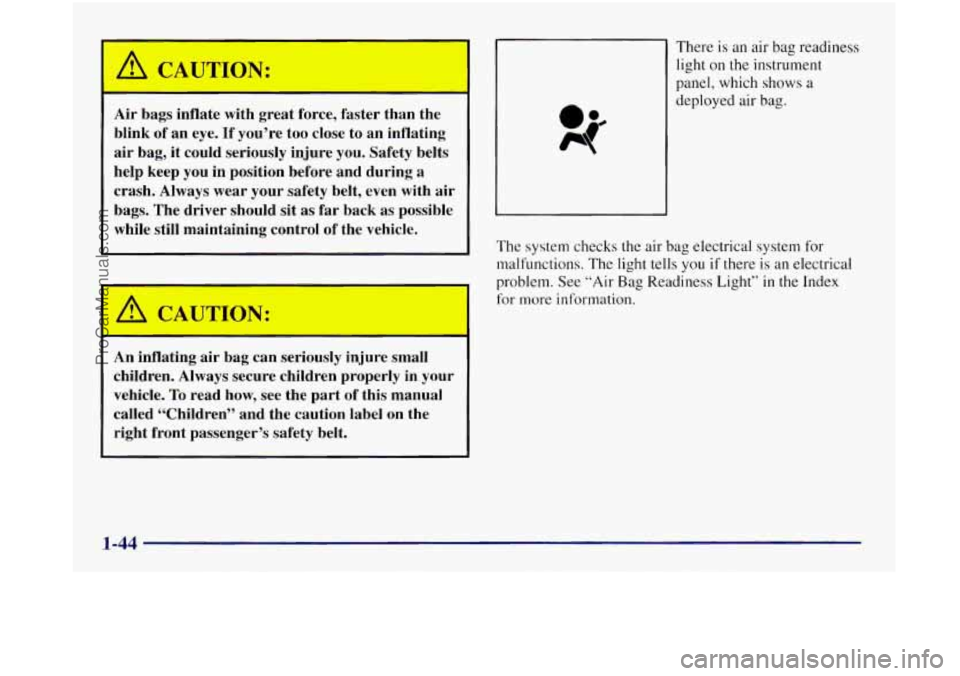
/I CAUTION:
Air bags inflate with great force, faster than the
blink of an eye.
If you’re too close to an inflating
air bag, it could seriously injure you. Safety belts
help keep you in position before and during a
crash. Always wear your safety belt, even with air
bags. The driver should sit
as far back as possible
while still maintaining control of the vehicle.
A CAUTION:
An inflating air bag can seriously injure small
children. Always secure children properly in your
vehicle.
To read how, see the part of this manual
called “Children” and the caution label on the
right front passenger’s safety belt.
There is an air bag readiness
light on the instrument
panel, which shows
a
The system checks the air bag electrical system for
malfunctions.
The light tells you if there is an electrical
problem. See “Air
Bag Readiness Light” in the Index
for
more information.
1-44
ProCarManuals.com
Page 53 of 436
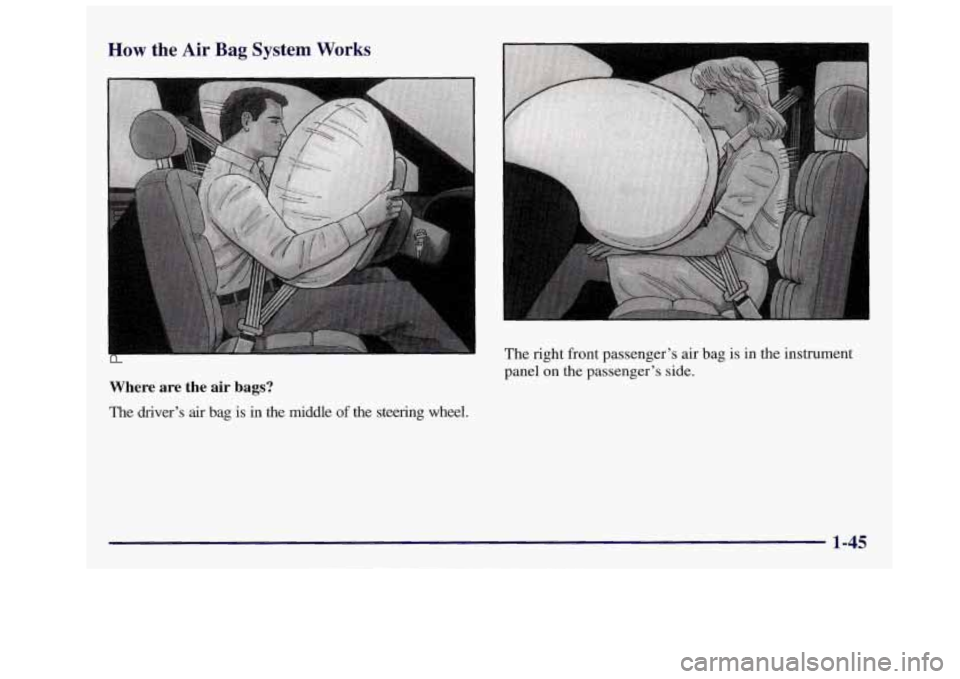
How the Air Bag System Works
Where are the air bags?
The driver’s air bag is in the middle of the steering wheel. The right front passenger’s air
bag is in the instrument
panel on the passenger’s
side.
1-45
ProCarManuals.com
Page 54 of 436
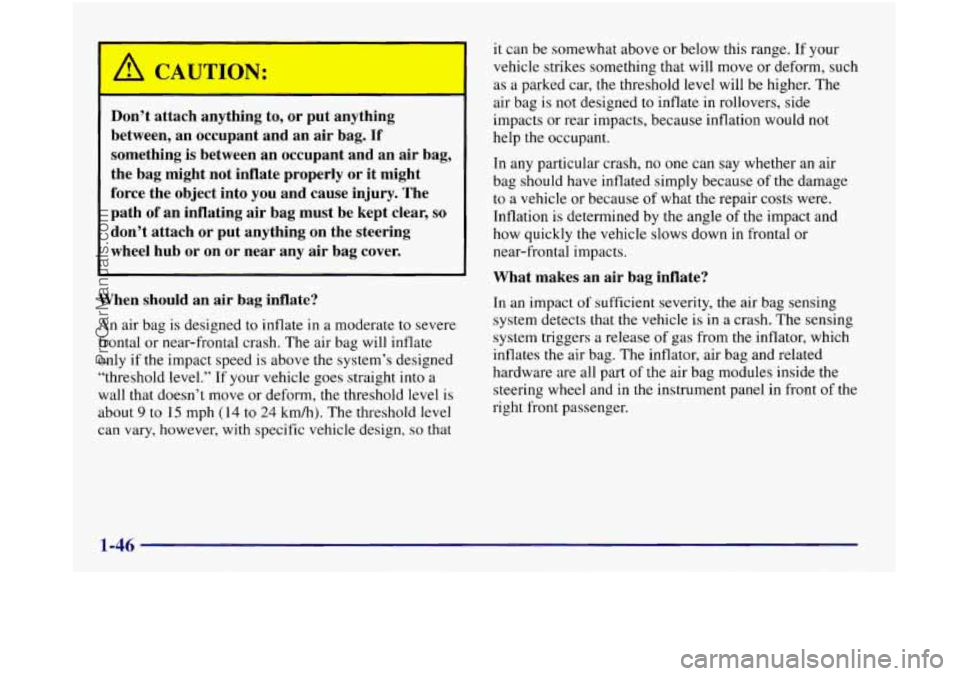
I
Don’t attach anything to, or put anything
between, an occupant and an air bag.
If
something is between an occupant and an air bag,
the bag might not inflate properly or it might
force the object into you and cause injury. The
path of an inflating air bag must be kept clear,
so
don’t attach or put anything on the steering
wheel hub or on or near any air bag cover.
When should an air bag inflate?
An air bag is designed to inflate in a moderate to severe
frontal or near-frontal crash. The air bag will inflate
only if the impact speed is above the system’s designed
“threshold level.’’
If your vehicle goes straight into a
wall that doesn’t move or deform, the threshold level
is
about 9 to 15 mph (14 to 24 kmk). The threshold level
can vary, however, with specific vehicle design,
so that
it can be somewhat above or below this range. If your
vehicle strikes something that will move or deform, such as a parked car,
the threshold level will be higher. The
air bag
is not designed to inflate in rollovers, side
impacts
or rear impacts, because inflation would not
help the occupant.
In any particular crash, no one can say whether an air
bag should have inflated simply because
of the damage
to a vehicle or because of what the repair costs were.
Inflation is determined by the angle of the impact and
how quickly
the vehicle slows down in frontal or
near-frontal impacts.
What makes an air bag inflate?
In an impact of sufficient severity, the air bag sensing
system detects that the vehicle
is in a crash. The sensing
system triggers
a release of gas from the inflator, which
inflates the air bag. The inflator, air bag and related
hardware are all part
of the air bag modules inside the
steering wheel and in the instrument panel in front
of the
right front passenger.
ProCarManuals.com
Page 55 of 436
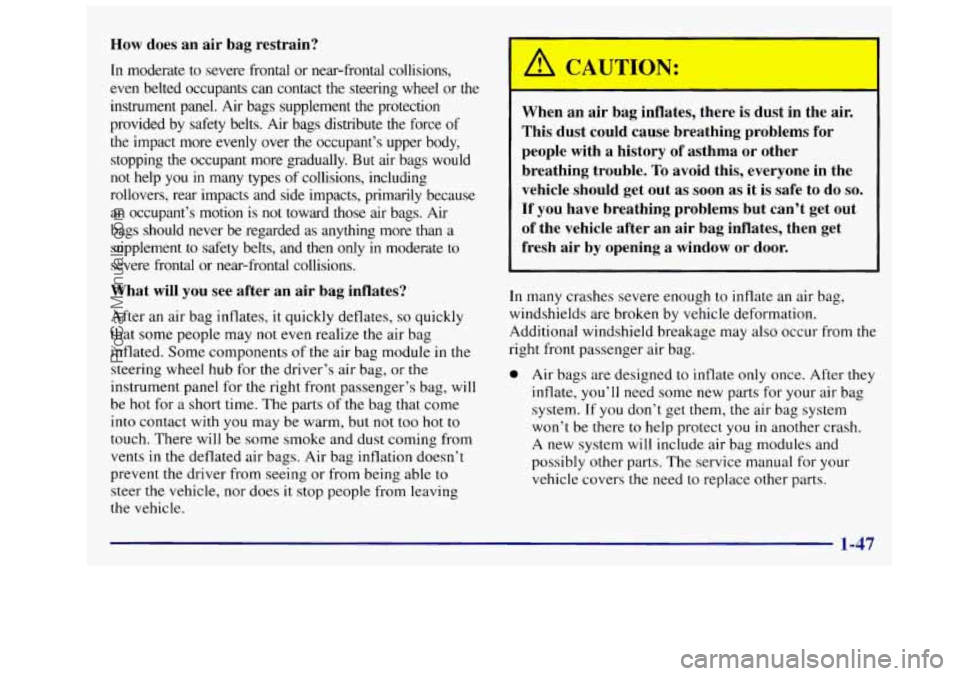
How does an air bag restrain?
In moderate to severe frontal or near-frontal collisions,
even belted occupants can contact the steering wheel or the
instrument panel. Air bags supplement the protection
provided by safety belts. Air bags distribute the force
of
the impact more evenly over the occupant’s upper body,
stopping the occupant more gradually. But air bags would
not help you in many types of collisions, including
rollovers, rear impacts and side impacts, primarily because
an occupant’s motion is not toward those air bags. Air
bags should never be regarded as anything more than a
supplement to safety belts, and then only in moderate to
severe frontal or near-frontal collisions.
What will you see after an air bag inflates?
After an air bag inflates, it quickly deflates, so quickly
that some people may not even realize the air bag
inflated. Some components of the air bag module in the
steering wheel hub for the driver’s air bag, or
the
instrument panel for the right front passenger’s bag, will
be hot for a short time. The parts of the bag that come
into contact with you may be warm, but not too hot
to
touch. There will be some smoke and dust coming from
vents in the deflated air bags. Air bag inflation doesn’t
prevent the driver from seeing or from being able to
steer the vehicle, nor does
it stop people from leaving
the vehicle.
When an air bag inflates, there is dust in the air.
This dust could cause breathing problems for
people with a history
of asthma or other
breathing trouble.
To avoid this, everyone in the
vehicle should get out as soon
as it is safe to do so.
If you have breathing problems but can’t get out
of the vehicle after an air bag inflates, then get
fresh air by opening a window or door.
In many crashes severe enough to inflate an air bag,
windshields are broken by vehicle deformation.
Additional windshield breakage may also occur from the
right front passenger air bag.
0 Air bags are designed to inflate only once. After they
inflate, you’ll need some new parts for your air bag
system.
If you don’t get them, the air bag system
won’t be there to help protect
you in another crash.
A new system will include air bag modules and
possibly other parts. The service manual for your
vehicle covers the need to replace other parts.
1-47
ProCarManuals.com
Page 56 of 436

Your vehicle is equipped with a crash sensing and
diagnostic module, which records information about
the air bag system. The module records information
about the readiness of the system, when the sensors are
activated and driver’s safety belt usage at deployment.
Let only qualified technicians work on your air bag
system. Improper service can mean that your air bag
system won’t work properly. See your retailer
for service.
NOTICE:
If you damage the cover for the driver’s or the
right front passenger’s air bag, the bag may not
work properly. You may have to replace the air
bag module in the steering wheel or both the air
bag module and the instrument panel for the
passenger’s air bag.
Do not open or break the air
bag covers.
Servicing Your Air Bag-Equipped
Oldsmobile
Air bags affect how your Oldsmobile should be
serviced. There are parts of the air bag system in several
places around your vehicle. You don’t want the system
to inflate while someone is working on your vehicle.
Your Oldsmobile retailer and the Silhouette Service
Manual have information about servicing your vehicle
and the air bag system. To purchase
a service manual,
see “Service and Owner Publications” in the Index.
For up to 10 minutes after the ignition key is
turned off and the battery is disconnected, an air
bag can still inflate during improper service. You
can be injured
if you are close to an air bag when
it inflates. Avoid yellow connectors. They are
probably part of the air bag system. Be sure
to
follow proper service procedures, and make sure
the person performing work for you is qualified
to
do so.
The air bag system does not need regular maintenance.
1-48
ProCarManuals.com
Page 89 of 436
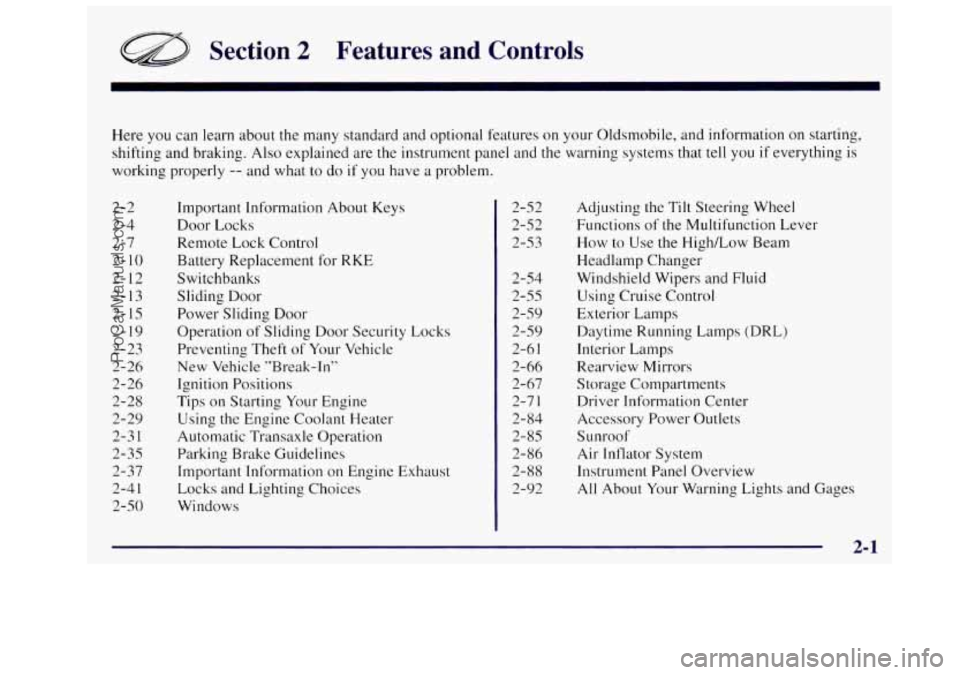
Section 2 Features and Controls
Here you can learn about the many standard and optional features on your Oldsmobile, and information on starting,
shifting and braking. Also explained are the instrument panel and the warning systems that
tell you if everything is
working properly
-- and what to do if you have a problem.
2-2 2-4
2-7
2-
10
2- 12
2-13 2-15
2-19
2-23
2-26 2-26
2-28 2-29
2-3 1
2-35
2-37
2-4
1
2-50 Important Information About Keys
Door Locks
Remote Lock
Control
Battery Replacement for RKE
Switchbanks
Sliding Door
Power Sliding Door
Operation of Sliding Door Security Locks
Preventing Theft
of Your Vehicle
New Vehicle "Break-In"
Ignition Positions
Tips on Starting
Your Engine
Using the Engine Coolant Heater
Automatic Transaxle Operation
Parking Brake Guidelines
Important Information on Engine Exhaust
Locks and Lighting Choices
Windows 2-52
2-52
2-53
2-54
2-55
2-59
2-59
2-6
I
2-66
2- 67
2-7
I
2- 84
2-85
2- 86
2-88
2-92 Adjusting the
Tilt Steering
Wheel
Functions of the Multifunction Lever
How to Use
the High/Low Beam
Headlamp Changer
Windshield Wipers and Fluid
Using Cruise Control
Exterior Lamps
Daytime Running Lamps (DRL)
Interior Lamps
Rearview Mirrors
Storage Compartments
Driver Information Center
Accessory Power Outlets
S u nroo f
Air Inflator System
Instrument Panel Overview
All About Your Warning Lights and Gages
ProCarManuals.com
Page 101 of 436

Instrument Panel Switchbank
This switchbank is located in the instrument panel below
the Comfort Controls. The switches and controls that
you may find
in this switchbank are the Rear Fan Knob,
Rear Window WiperNasher, Fog Lamps and Traction
Control.
If your vehicle does not have some of the
options controlled by these switches, there will
be a
blank button
in its place.
For more information, please see each
of these features
in the Index.
If your vehicle is not equipped with the Optional Rear
Climate Control system, there
will be a storage space in
this switchbank. The rubber mat can be removed for
cleaning. Snap the mat into place after cleaning.
Sliding Door
To open the sliding door from outside the vehicle, pull
the handle out and then pull the door toward
the rear. If
you slide the door all the way back, the door will rest in
a detent position. The door must overcome this detent
when closing.
To move the door forward, you must first pull the door
past
the open detent position.
Does your Oldsmobile have a sliding door on the left
side? If
it does, this door is designed to open only a little
if the fuel door is open. If this ever happens, don’t try to
force
the sliding door. Just close the left-side sliding
door. Then when the fuel filler door is closed, the
left-side sliding door can be opened normally.
2-13
ProCarManuals.com
Page 110 of 436
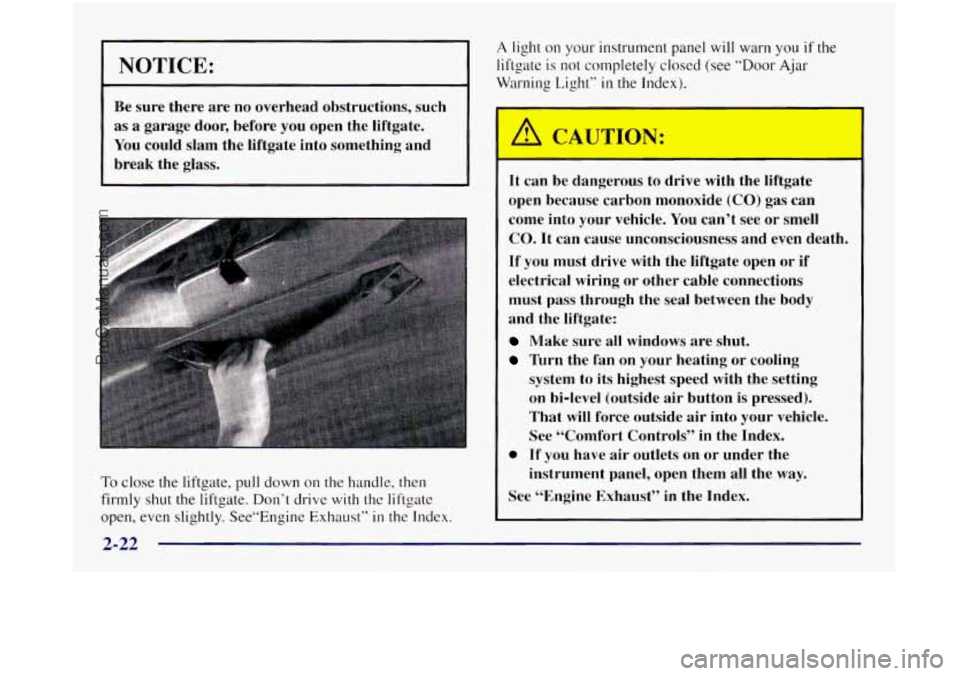
~ NOTICE:
Be
sure there are no overhead obstructions, such
as a garage door, before you open the liftgate.
You could slam the liftgate into something and
break the glass.
To close the liftgate, pull down on the handle, then
firmly shut
the liftgate. Don’t drive with the liftgate
open, even slightly. See“Engine Exhaust” in the Index.
A light on your instrument panel will warn you if the
liftgate is not completely closed (see “Door Ajar
Warning Light” in the Index).
It can be dangerous to drive with the liftgate
open because carbon monoxide (CO) gas can
come into your vehicle. You can’t see or smell
CO. It can cause unconsciousness and even death.
If you must drive with the liftgate open or if
electrical wiring or other cable connections
must pass through the seal between the body
and the liftgate:
Make sure all windows are shut.
Turn the fan on your heating or cooling
system to its highest speed with the setting
on bi-level (outside air button
is pressed).
That
will force outside air into your vehicle.
See “Comfort Controls”
in the Index.
0 If you have air outlets on or under the
instrument panel, open them all the way.
See “Engine Exhaust” in the Index.
2-22
ProCarManuals.com
Page 111 of 436

Content Theft-Deterrent (Option)
If your vehicle has this option, it has a theft-deterrent
alarm system.
A light located on top of your instrument panel (near the
center
of the vehicle, next to the windshield) will flash
slowly to let everyone
know that the system has
been armed.
While armed, the doors will not unlock
with the power
lock switch. Once armed,
the alarm will
go off if someone tries to
enter the vehicle (without using the key chain
transmitter or a key), breaks a window, tries
to damage
the vehicle or turns the ignition on. The horn will sound
and your vehicle’s park lamps will flash for up to
two
minutes. The system will also cut off the fuel supply,
preventing the vehicle from being driven.
When the alarm is armed, the liftgate may be opened
with the key chain transmitter or with a key.
Arming with the Power Lock Switch
Your alarm system will arm when you use either power
lock switch to lock
the doors while any door or the
liftgate is open and the key is removed from the ignition
(if you would like to turn off power lock switch arming,
see “Locks and Lighting Choices”
in the Index).
The security light flashes quickly to let you know when
the system
is ready to arm with the power door lock
switches. The security light will stop flashing and stay
011, when you press the rear of the power lock switch, to
let you know the system is arming. After all doors and
the liftgate are closed and locked, the security light will
begin flashing
at a very slow rate to let you know the
system is armed.
2-23
ProCarManuals.com